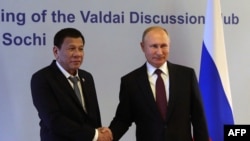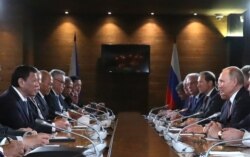Philippine President Rodrigo Duterte’s meeting this week with Vladimir Putin in Russia signals Moscow's interest in playing a tricky but persuasive role in the South China Sea maritime sovereignty dispute now dominated by China and the United States, specialists in the region say.
Duterte is visiting Russia October 1-5, partly to speak with Putin about increasing security and defense cooperation, the Philippine presidential office website says. Duterte toured Vnukovo Military Base Airport in Moscow on Wednesday.
Russia might offer to sell arms to the Philippines, experts say, having sold weapons to other Southeast Asian countries claiming the 3.5 million-square-kilometer sea. Russian arms sales to the Philippines would reduce U.S. military influence in the sea but yet be handled in ways that avoid weakening the presence of Moscow’s decades-old friend, Beijing, they add.
“For Russia, I think it’s clear U.S. influence is very extensive in the Philippines, so by selling arms to the Philippines they are in effect promoting their political influence,” said Aaron Rabena, a research fellow at Asia-Pacific Pathways to Progress Foundation, a Manila research organization.
“There might be certain concern by China about what type of weapons we will get from the Russians and where those weapons will be used,” Rabena added. Were they to be used in the South China Sea, he said, "then the Chinese might raise their eyebrows.”
South China Sea dispute
Brunei, China, Malaysia, Taiwan, Vietnam and the Philippines claim all or parts of the sea. China, which calls about 90% of the waterway its own, has taken a military and technological lead during the past decade, prompting the weaker claimants to seek help from abroad – often from the United States.
Russia has no claim to the tropical sea that’s prized for fisheries and energy reserves. However, it hopes to flex muscle in support of China, said Termsak Chalermpalanupap, fellow with the ISEAS Yusof Ishak Institute in Singapore.
“In the South China Sea, Moscow always supports Beijing,” he said. “They want to be recognized as a superpower, because now we only see U.S.A. and China, and then tend to forget that Russia or the Soviet Union used to be one of the superpowers.”
China and Russia often back each other in resisting the United States, a mutual Cold War foe. China is involved in disputes with the United States over trade and its maritime expansion, while Moscow spars with Washington over cybersecurity and military-security matters in Eastern Europe.
Since 2017, Washington has stepped up pressure on China to limit maritime expansion. The U.S. Navy regularly sends ships into the sea and helps Southeast Asian states militarily.
The Philippines normally looks to its old ally the United States for military support -- which it has received since 1951. Since his 2016 election, Duterte has pursued a multi-country foreign relations strategy, including establishing his country’s strongest friendship ever with China.
A future Russian-Philippine friendship might give Moscow’s ships valuable access to the sea and adjacent tropical Pacific Ocean, said Eduardo Araral, associate professor at the National University of Singapore’s public policy school.
That advantage would help cargo shipments reach Russia’s colder Pacific port in Vladivostok, he said.
“Having a friend in Duterte means the Russian ships can stop over on their way to the Pacific,” Araral said. “In other words, they can do much more power projection if they have the Philippines as a friendly ally.”
Regional arms supplier
Russia is already Vietnam’s main arms supplier and sales from Russia since 2011 have helped it upgrade its “capability to conduct sea operations in the East Sea,” the U.S. Commerce Department says, referring to the South China Sea.
In 2011 Vietnam bought two batteries of coastal missile systems from Russia, and a year later acquired two batteries of long-range surface-to-air missile systems, Commerce says on its International Trade Administration website.
In Malaysia, Russia is helping now to rehab 18 Sukhoi flanker fighter planes to make them useful for another 15 years, the Malaysian news website the New Straits Times reported in March. Russia was exploring sales of Su-35 fighter jets to Malaysia at that time too, the website said.
To shore up ties with Southeast Asia overall, in 2016 Putin tried to “revive partnerships” through a summit with the 10-nation Association of Southeast Asian Nations bloc, Chalermpalanupap said.
The Philippines wants to “diversify” arms sources, Rabena said. Unlike some Western governments, Russia does not consider the Duterte government’s deadly campaign against illegal drugs when deciding whether to sell arms, Araral said.
China is used to Russia’s sales to Vietnam, analysts believe. To avoid angering Beijing over the Philippines, though, Moscow might earmark any arms sold there for helping resist Muslim rebels rather than for protecting the country's South China Sea interests, Rabena said.







